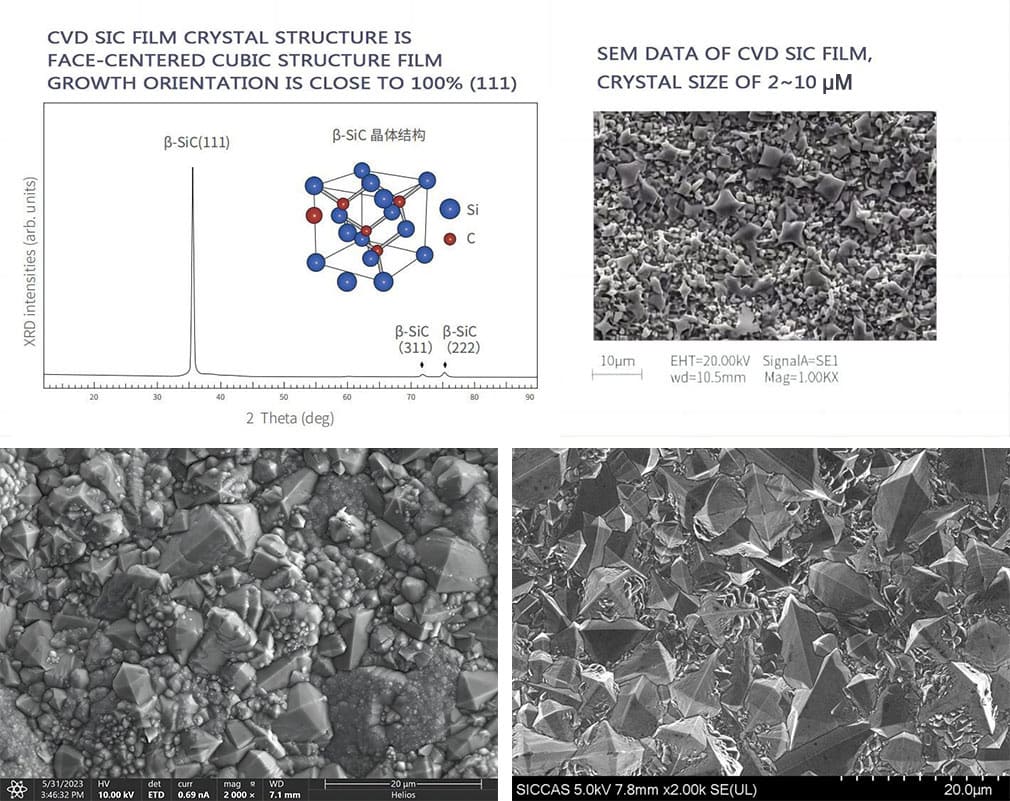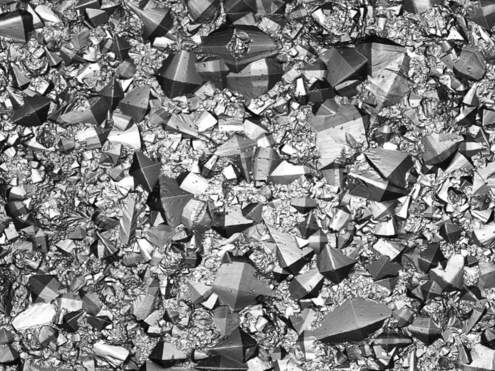Silicon Carbide is a hard compound containing silicon and carbon, and is found in nature as the extremely rare mineral moissanite. Silicon carbide particles can be bonded together by sintering to form very hard ceramics, which are widely used in applications requiring high durability, especially in semiconductor procession.
Physical structure of SiC
What is SiC Coating?
SiC coating is a dense, wear-resistant silicon carbide coating with high corrosion and heat resistance and excellent thermal conductivity. This high-purity SiC coating is primarily used in the semiconductor and electronics industries to protect wafer carriers, bases and heating elements from corrosive and reactive environments. SiC coating is also suitable for vacuum furnaces and sample heating in high vacuum, reactive and oxygen environments.
High purity SiC coating surface
What is the SiC coating process?
A thin layer of silicon carbide is deposited on the surface of the substrate using CVD (Chemical Vapor Deposition). Deposition is usually carried out at temperatures of 1200-1300°C and the thermal expansion behavior of the substrate material should be compatible with the SiC coating to minimize thermal stress.

CVD SIC Coating FILM CRYSTAL STRUCTURE
The physical properties of SiC coating are mainly reflected in its high temperature resistance, hardness, corrosion resistance and thermal conductivity.
Typical physical parameters are usually as follows:
Hardness: SiC coating typically have a Vickers Hardness in the range of 2000-2500 HV, which gives them extremely high wear and impact resistance in industrial applications.
Density: SiC coatings typically have a density of 3.1-3.2 g/cm³. The high density contributes to the mechanical strength and durability of the coating.
Thermal conductivity: SiC coatings have a high thermal conductivity, typically in the range of 120-200 W/m-K (at 20°C). This gives it good thermal conductivity in high temperature environments and makes it particularly suitable for heat treatment equipment in the semiconductor industry.
Melting point: silicon carbide has a melting point of approximately 2730°C and has excellent thermal stability at extreme temperatures.
Coefficient of Thermal Expansion: SiC coatings have a low linear coefficient of thermal expansion (CTE), typically in the range of 4.0-4.5 µm/m-K (in the 25-1000℃). This means that its dimensional stability is excellent over large temperature differences.
Corrosion resistance: SiC coatings are extremely resistant to corrosion in strong acid, alkali and oxidizing environments, especially when using strong acids (such as HF or HCl), their corrosion resistance far exceeds that of conventional metal materials.
SiC coating application substrate
SiC coating is often used to improve the corrosion resistance, high temperature resistance, and plasma erosion resistance of the substrate. Common application substrates include the following:
| Substrate type | Application reason | Typical use |
| Graphite | - Light structure, good thermal conductivity
- But easily corroded by plasma, requires SiC coating protection |
Vacuum chamber parts, graphite boats, plasma etching trays, etc. |
| Quartz (Quartz/SiO₂) | - High purity but easily corroded
- Coating enhances plasma erosion resistance |
CVD/PECVD chamber parts |
| Ceramics (such as alumina Al₂O₃) | - High strength and stable structure
- Coating improves surface corrosion resistance |
Chamber lining, fixtures, etc. |
| Metals (such as molybdenum, titanium, etc.) | - Good thermal conductivity but poor corrosion resistance
- Coating improves surface stability |
Special process reaction components |
| Silicon carbide sintered body (SiC bulk) | - For environments with high requirements for complex working conditions
- Coating further improves purity and corrosion resistance |
High-end CVD/ALD chamber components |
SiC coated products are commonly used in the following semiconductor areas
SiC coating products are widely used in semiconductor processing, mainly in high temperature, high corrosion and strong plasma environments. The following are several major application processes or fields and brief descriptions:
| Application process/field | Brief description | Silicon Carbide Coating function |
| Plasma etching (Etching) | Use fluorine or chlorine-based gases for pattern transfer | Resist plasma erosion and prevent particle and metal contamination |
| Chemical vapor deposition (CVD/PECVD) | Deposition of oxide, nitride and other thin films | Resist corrosive precursor gases and increase component life |
| Physical vapor deposition (PVD) chamber | High-energy particle bombardment during the coating process | Improve the erosion resistance and heat resistance of the reaction chamber |
| MOCVD process (such as SiC epitaxial growth) | Long-term reaction under high temperature and high hydrogen corrosive atmosphere | Maintain equipment stability and prevent contamination of growing crystals |
| Heat treatment process (LPCVD, diffusion, annealing, etc.) | Usually carried out at high temperature and vacuum/atmosphere | Protect graphite boats and trays from oxidation or corrosion |
| Wafer carrier/chuck (Wafer handling) | Graphite base for wafer transfer or support | Reduce particle shedding and avoid contact contamination |
| ALD chamber components | Repeatedly and accurately control atomic layer deposition | The coating keeps the chamber clean and has high corrosion resistance to precursors |
Why choose VET Energy?
VET Energy is a leading manufacturer, innovator and leader of SiC coating products in China, the main SiC coating products include wafer carrier with SiC coating, SiC coated epitaxial susceptor, SiC coated graphite ring, Half-moon parts with SiC coating, SiC coated carbon-carbon composite, SiC coated wafer boat, SiC coated heater, etc. VET Energy is committed to providing the semiconductor industry with the ultimate technology and product solutions, and supports customization services. We sincerely look forward to being your long-term partner in China.
If you have any inquiries or need additional details, please don’t hesitate to get in touch with us.
Whatsapp&Wechat:+86-18069021720
Email: steven@china-vet.com
Post time: Oct-18-2024

